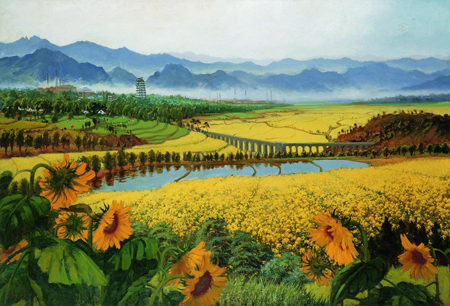
Yellow Blooms on the Battlefield Smell Sweeter was sold for RMB 80.5 million, a record high for a piece by Wu Zuoren.
It was this poem written by the late Chinese leader that inspired Wu Zuoren’s (1908-1997) Yellow Blooms on the Battlefield Smell Sweeter, which sold at the China Guardian 2013 Spring Auction for RMB 80.5 million, a record high for Wu’s work. Wu created this oil painting in September 1977 to commemorate the iconic leader’s life on the first anniversary of his death.
This panoramic painting expresses the passion and joy present in the poem, evoking the emotions aroused in Mao by the coming of the new era almost a century ago, along with the painter’s own expectations of the future.
In the painting Wu skillfully combines Western techniques that highlight perspective and realism with Chinese composition and emotional expression, which embodies his approach to art.
Its impressionistic foreground of vibrant sunflowers and rape blossom recedes into a wide expanse of farmland, whose far edge gives way to dense forests amid which loom factory buildings and the landmark pagoda of Yan’an. Behind them a distant mountain range obscured by light mist fades into a bold sky, adding to the painting’s powerful sense of depth. The abundance of greens and yellows represents the vitality of life, conveying the hope and passion the artist holds for the future of his country.
By the time Yellow Blooms was painted, Wu already had an established style and reputation in China’s art circles. Born in Suzhou City of Jiangsu Province, famous for its beautiful gardens, he dropped out of school at a young age and taught himself painting. In 1926, he enrolled at a vocational college to study art. In the following years he took painting courses at three universities in Shanghai and Nanjing. Among his tutors was one of the greatest artists in modern Chinese history, Xu Beihong (1895-1953). In 1929, the 22-year-old Wu published one of his sketches in Southern China Weekly – Warship below the God of Peace, which made him well known in the Chinese art scene.
In 1930 Wu traveled to Paris and Brussels for further studies. In his second year at Belgium’s Royal Academy of Fine Arts, he was awarded first place in an oil painting competition and honored as a Laureate Student. The school’s then president Alfred Bastien thought highly of Wu’s originality, remarking that his works were characterized by neither the style of influential French painter Vlaminck nor traditional Chinese painting but had their own distinctive features.
In 1935, upon the invitation of Xu Beihong, Wu returned to China to teach in the Art Department of the Central University, now known as Nanjing University. During the War of Resistance Against Japanese Aggression, Wu led a group of painters who ventured to the frontline and captured the action on canvas. They also made many trips to the great wildernesses in Shaanxi, Gansu and Qinghai and Tibet, where they collected creative materials and copied the murals in the Dunhuang grottoes.
